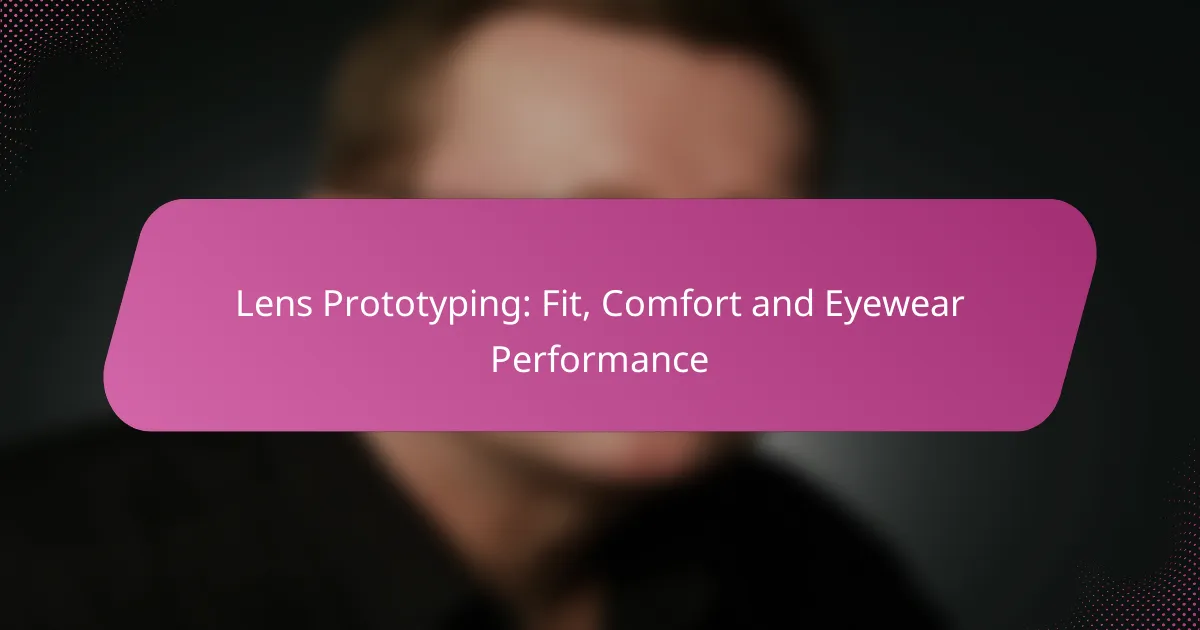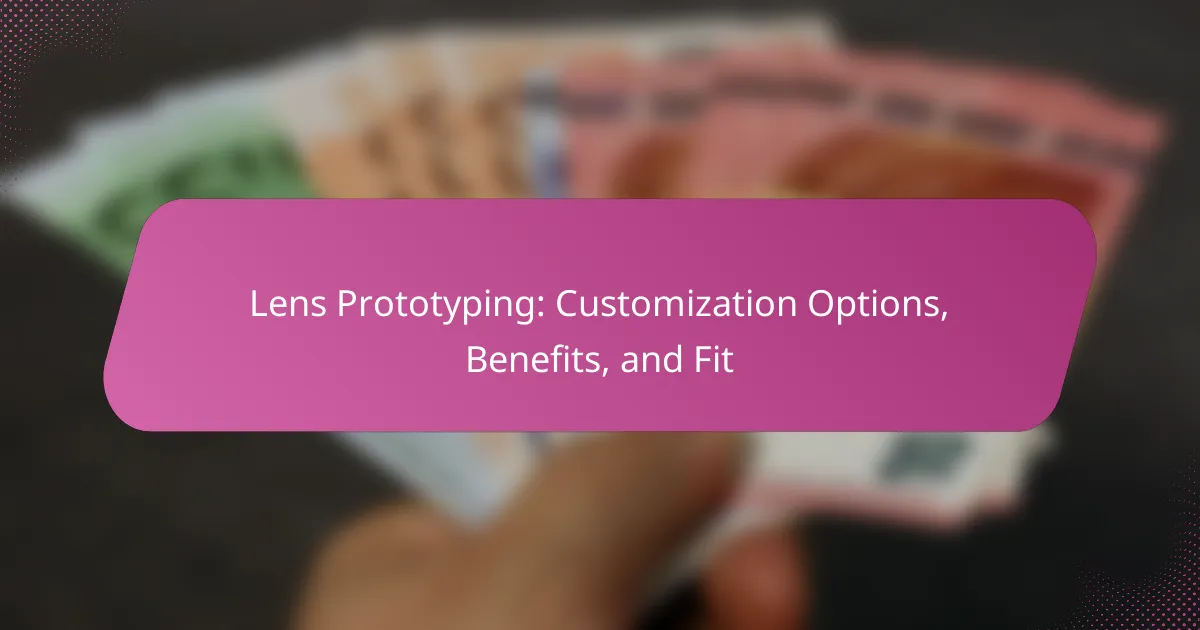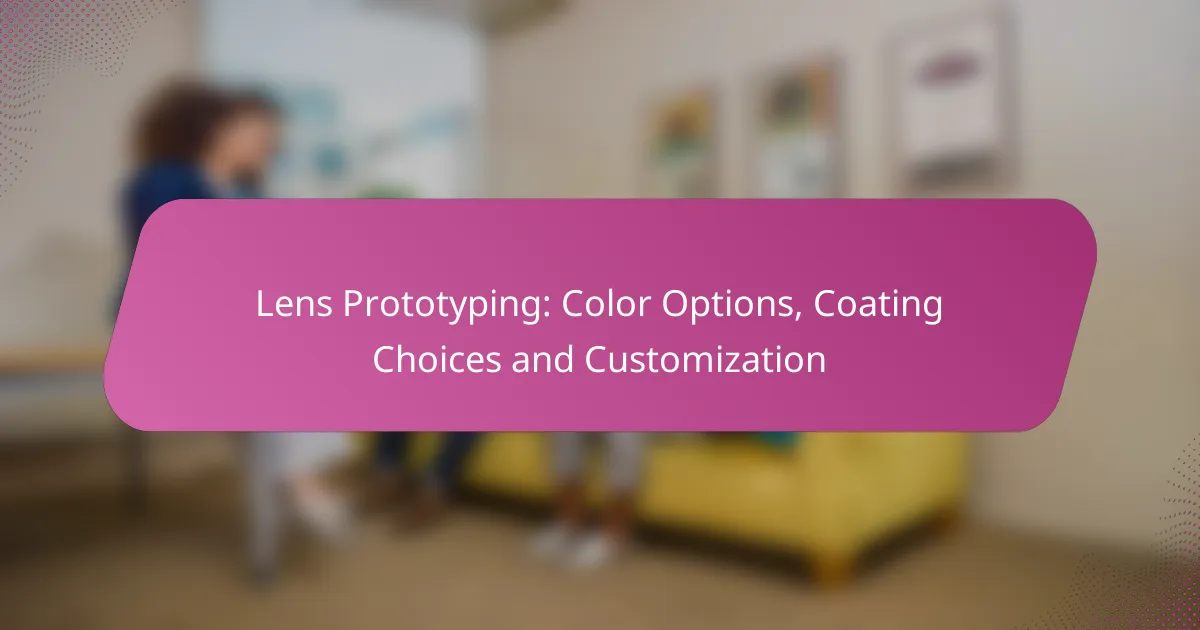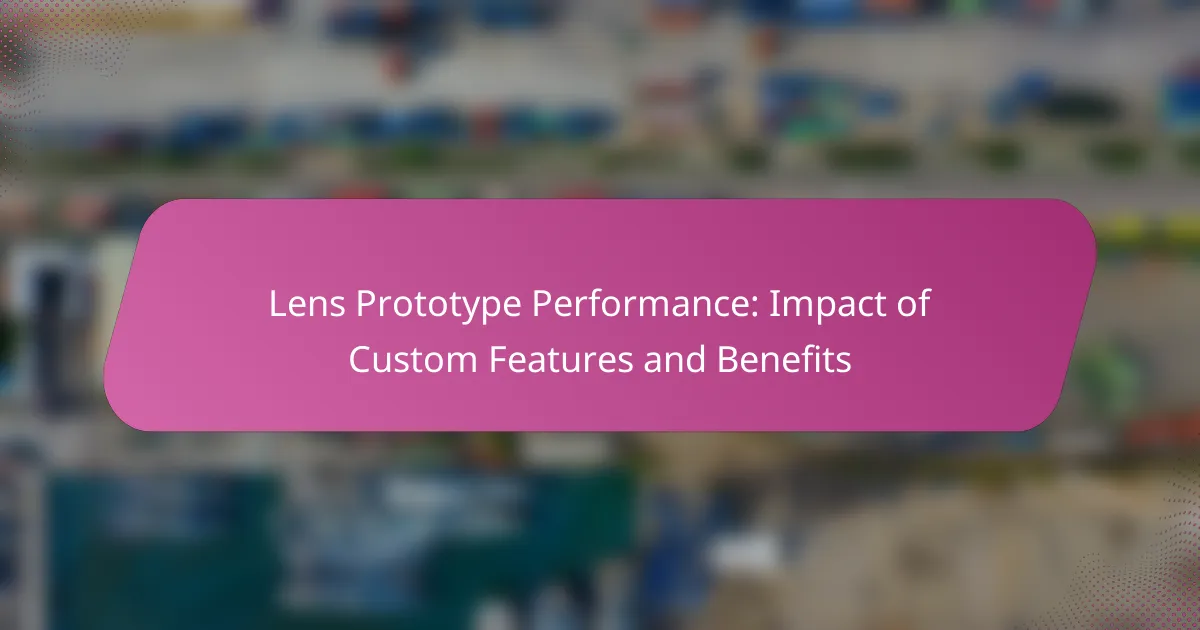Lens prototyping is essential for achieving optimal fit and comfort in eyewear, as it considers the interplay between lens shape, frame size, and material. By focusing on these elements, wearers can enjoy a comfortable experience while ensuring their lenses perform effectively in various conditions. Leading brands like Essilor, Zeiss, and Ray-Ban utilize advanced technology to refine these aspects, enhancing overall eyewear performance.
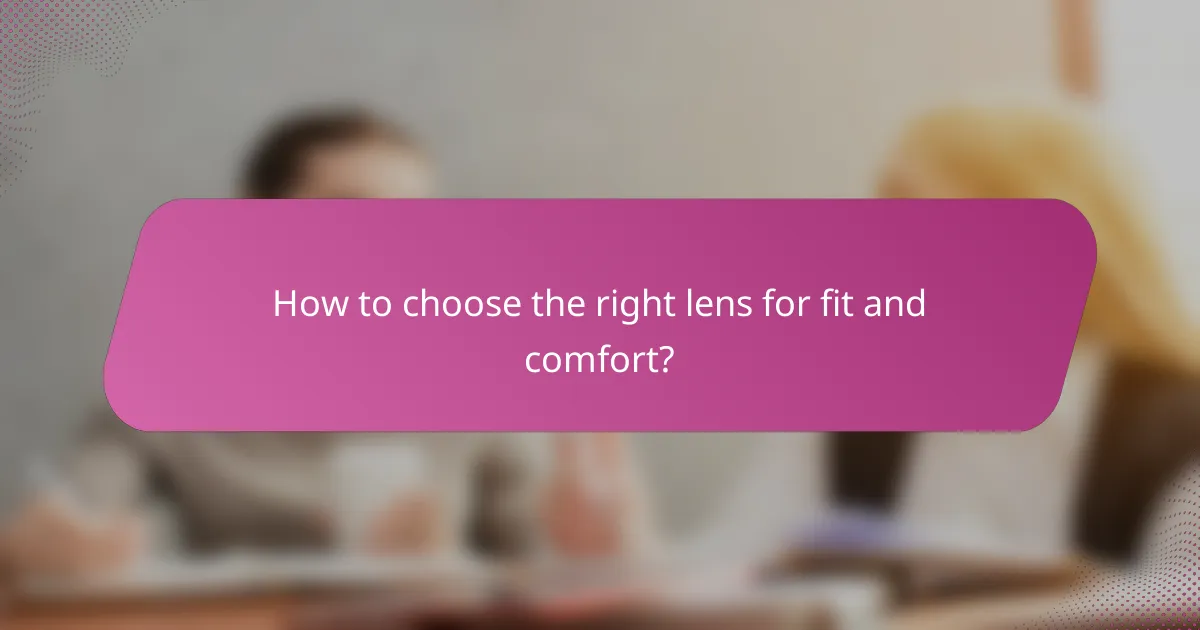
How to choose the right lens for fit and comfort?
Choosing the right lens for fit and comfort involves understanding how lens shape, frame size, and material affect overall eyewear performance. Prioritizing these factors ensures that your lenses not only fit well but also provide a comfortable wearing experience throughout the day.
Consider lens shape and curvature
The shape and curvature of the lens play a crucial role in how well they fit your face and provide visual clarity. Lenses can be flat, spherical, or aspheric, each offering different benefits in terms of distortion and field of view. For instance, aspheric lenses are often thinner and lighter, making them a popular choice for higher prescriptions.
When selecting lens curvature, consider your prescription and the type of eyewear you need. A more curved lens can enhance peripheral vision but may not be suitable for all frame styles. It’s essential to try on different shapes to see which provides the best comfort and visual performance.
Evaluate frame size and design
Frame size and design significantly impact lens fit and comfort. A well-fitted frame should sit comfortably on your nose and ears without pinching or slipping. Measure your face to find the right frame size, typically indicated by the lens width, bridge width, and temple length.
Additionally, consider the frame style—full-rim, semi-rimless, or rimless—as each affects how the lenses are held and how they interact with your face. For example, full-rim frames can provide better support for thicker lenses, while rimless designs may offer a lighter feel.
Assess material options for comfort
The material of the lenses can greatly influence comfort, weight, and durability. Common lens materials include polycarbonate, high-index plastic, and glass. Polycarbonate is lightweight and impact-resistant, making it ideal for active lifestyles, while high-index plastic is thinner and lighter for stronger prescriptions.
When choosing lens materials, consider your daily activities and how the lenses will be used. For instance, if you spend a lot of time outdoors, look for lenses with UV protection and anti-reflective coatings to enhance comfort and visual clarity. Always consult with an eyewear professional to find the best material suited to your needs.

What factors influence eyewear performance?
Eyewear performance is influenced by several key factors, including lens coatings, thickness, and UV protection. Each of these elements plays a crucial role in how well the eyewear functions in various conditions and affects user comfort and vision quality.
Lens coatings and treatments
Lens coatings and treatments enhance the functionality and durability of eyewear. Common options include anti-reflective coatings, which reduce glare, and scratch-resistant treatments that prolong the life of the lenses. Choosing the right coating can significantly improve visual clarity and comfort, especially in bright or challenging lighting conditions.
When selecting coatings, consider your lifestyle. For instance, if you frequently use digital devices, blue light blocking coatings may be beneficial. Additionally, hydrophobic treatments can help repel water and smudges, making lenses easier to clean.
Impact of lens thickness on vision
Lens thickness can affect both the weight of the eyewear and the optical performance. Thicker lenses may lead to increased distortion at the edges, impacting peripheral vision. Conversely, thinner lenses can provide a more comfortable fit and a wider field of view, especially for higher prescriptions.
When choosing lens thickness, consider the prescription strength. For stronger prescriptions, high-index lenses are a good option as they are thinner and lighter. This can enhance comfort, particularly for all-day wear.
Importance of UV protection
UV protection is essential for safeguarding your eyes from harmful ultraviolet rays. Prolonged exposure to UV light can lead to eye conditions such as cataracts and macular degeneration. Quality eyewear should offer 100% UV protection to ensure safety during outdoor activities.
When purchasing eyewear, look for labels indicating UV protection levels. Many sunglasses and prescription lenses now come with built-in UV filters, but it’s crucial to verify this feature. Opting for eyewear with adequate UV protection is a simple yet effective way to maintain long-term eye health.

Which brands excel in lens prototyping?
Several brands are recognized for their excellence in lens prototyping, particularly Essilor, Zeiss, and Ray-Ban. These companies leverage advanced technology and design principles to enhance fit, comfort, and overall eyewear performance.
Essilor’s advanced lens technology
Essilor is known for its innovative lens technology, which includes a variety of lens designs tailored to different visual needs. Their products often incorporate digital surfacing techniques that allow for precise customization, improving both clarity and comfort.
One notable offering is the Varilux series, which provides progressive lenses designed to reduce distortion and enhance peripheral vision. This is particularly beneficial for users transitioning between different focal distances.
Zeiss’s precision optics
Zeiss specializes in precision optics, ensuring that their lenses provide exceptional clarity and performance. Their lenses are crafted using advanced manufacturing processes that focus on minimizing aberrations and maximizing visual acuity.
The Zeiss DriveSafe lenses are specifically designed for driving, featuring anti-reflective coatings that reduce glare and enhance contrast. This makes them an excellent choice for those who spend significant time on the road.
Ray-Ban’s comfort-focused designs
Ray-Ban emphasizes comfort in its eyewear designs, often integrating lightweight materials and ergonomic shapes. Their lenses are designed to fit seamlessly within the frames, ensuring a snug yet comfortable fit for all-day wear.
For example, Ray-Ban’s RB2132 New Wayfarer sunglasses feature a slightly smaller frame that accommodates a wider range of face shapes, enhancing comfort without sacrificing style. This focus on fit is crucial for users who prioritize comfort in their eyewear choices.

How does lens prototyping improve user experience?
Lens prototyping enhances user experience by allowing for tailored designs that prioritize fit, comfort, and performance. This iterative process enables manufacturers to refine eyewear based on direct feedback, ensuring that the final product meets individual preferences and needs.
Customization for individual needs
Customization is key in lens prototyping, as it allows for adjustments based on the unique facial features and visual requirements of each user. Factors such as prescription strength, frame style, and personal preferences can all be incorporated into the design process.
For example, users with specific visual impairments may require specialized lens coatings or shapes to enhance clarity and reduce glare. This level of personalization leads to a more satisfying and effective eyewear experience.
Testing for optimal fit and comfort
Testing during the prototyping phase is crucial for achieving an optimal fit and comfort level. By creating multiple iterations of lens designs, manufacturers can gather user feedback on aspects like weight distribution and pressure points.
Common practices include using 3D modeling and virtual try-on technologies to simulate how different lenses will feel in real-world conditions. This approach helps identify potential discomfort before mass production, ensuring that the final product is both comfortable and functional.

What are the latest trends in lens prototyping?
The latest trends in lens prototyping focus on enhancing fit, comfort, and performance through advanced technologies. Innovations such as 3D printing and smart lenses with augmented reality are transforming how eyewear is designed and manufactured, allowing for more personalized and functional products.
3D printing innovations
3D printing is revolutionizing lens prototyping by enabling rapid production of customized eyewear. This technology allows designers to create intricate shapes and structures that traditional manufacturing methods cannot achieve, resulting in better-fitting lenses tailored to individual facial features.
Additionally, 3D printing reduces lead times significantly, often allowing prototypes to be produced within hours rather than days. This speed facilitates quicker iterations and adjustments based on user feedback, enhancing overall design efficiency.
Smart lenses with augmented reality
Smart lenses equipped with augmented reality (AR) are becoming increasingly popular in lens prototyping. These lenses can overlay digital information onto the real world, providing users with enhanced experiences, such as navigation or real-time data display.
When prototyping smart lenses, developers must consider factors like battery life, weight, and user comfort. Balancing these elements is crucial to ensure that the lenses remain practical for everyday use while delivering the desired technological benefits.

How to evaluate lens prototyping services?
To evaluate lens prototyping services, consider their quality, reliability, and customer satisfaction. Focus on key factors such as industry certifications, customer feedback, and the overall performance of the eyewear produced.
Check for industry certifications
Industry certifications are crucial indicators of a lens prototyping service’s credibility and quality. Look for certifications from recognized organizations such as the International Organization for Standardization (ISO) or the American National Standards Institute (ANSI), which ensure that the lenses meet specific safety and performance standards.
Additionally, check if the service complies with local regulations regarding eyewear manufacturing. For example, in the European Union, lenses must adhere to the EU Medical Device Regulation (MDR) to ensure safety and efficacy.
Review customer feedback and testimonials
Customer feedback provides valuable insights into the performance and reliability of lens prototyping services. Look for reviews on independent platforms or forums where users share their experiences regarding fit, comfort, and overall eyewear performance.
Consider reaching out to previous clients for testimonials or case studies. This can help you gauge the service’s ability to meet specific needs, such as custom prescriptions or unique lens designs, and identify any common issues that may arise.
